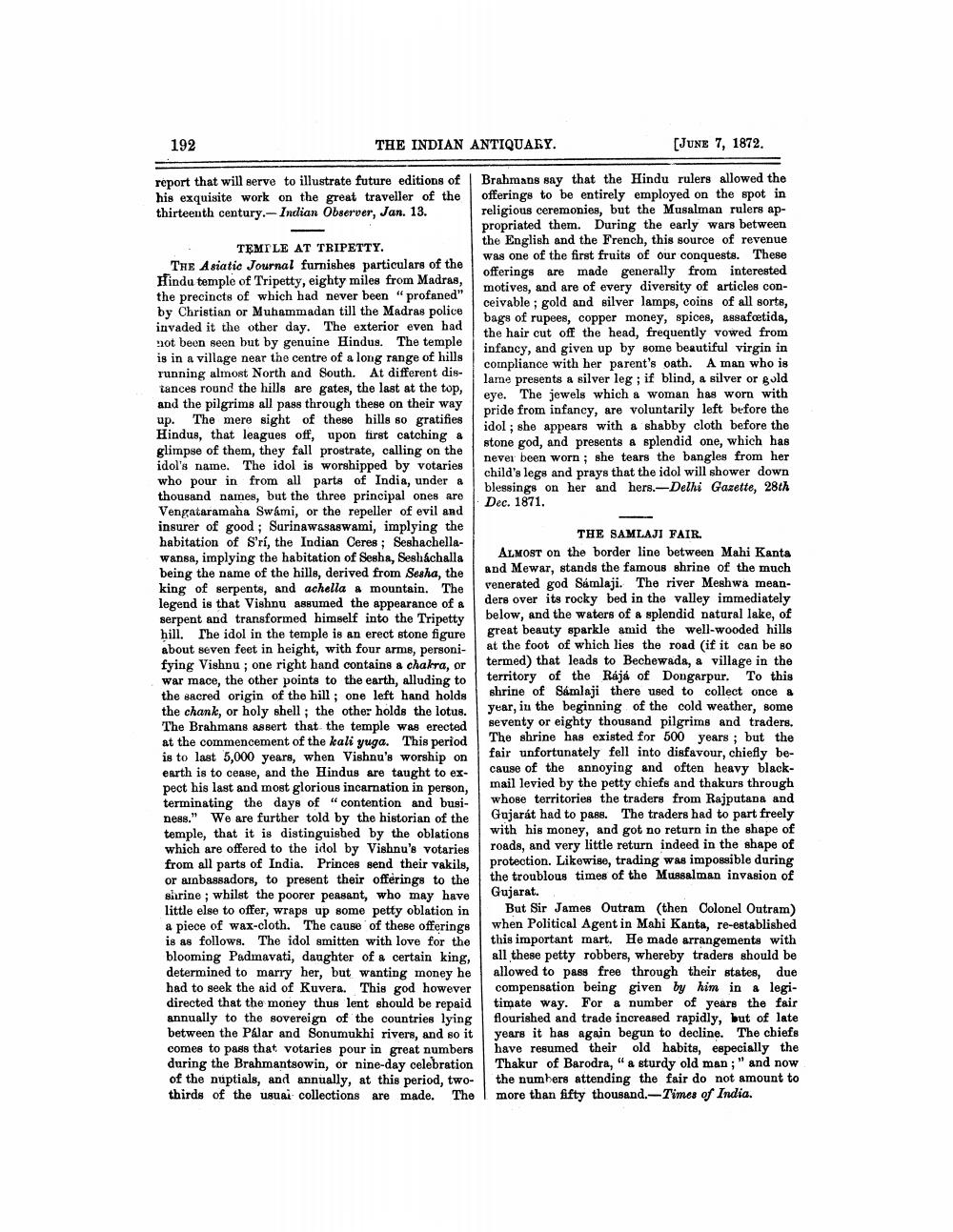________________
192
THE INDIAN ANTIQUARY.
[JUNE 7, 1872.
Brahmans say that the Hindu rulers allowed the offerings to be entirely employed on the spot in religious ceremonies, but the Musalman rulers appropriated them. During the early wars between the English and the French, this source of revenue was one of the first fruits of our conquests. These offerings are made generally from interested motives, and are of every diversity of articles conceivable; gold and silver lamps, coins of all sorts, bags of rupees, copper money, spices, assafoetida, the hair cut off the head, frequently vowed from infancy, and given up by some beautiful virgin in compliance with her parent's oath. A man who is lame presents a silver leg; if blind, a silver or gold eye. The jewels which a woman has worn with pride from infancy, are voluntarily left before the idol; she appears with a shabby cloth before the stone god, and presents a splendid one, which has never been worn; she tears the bangles from her child's legs and prays that the idol will shower down blessings on her and hers.-Delhi Gazette, 28th · Dec. 1871.
report that will serve to illustrate future editions of his exquisite work on the great traveller of the thirteenth century.-Indian Observer, Jan. 13.
TEMPLE AT TRIPETTY.
THE Asiatic Journal furnishes particulars of the Hindu temple of Tripetty, eighty miles from Madras, the precincts of which had never been "profaned" by Christian or Muhammadan till the Madras police invaded it the other day. The exterior even had not been seen but by genuine Hindus. The temple is in a village near the centre of a long range of hills running almost North and South. At different distances round the hills are gates, the last at the top, and the pilgrims all pass through these on their way up. The mere sight of these hills so gratifies Hindus, that leagues off, upon first catching a glimpse of them, they fall prostrate, calling on the idol's name. The idol is worshipped by votaries who pour in from all parts of India, under a thousand names, but the three principal ones are Vengataramaha Swami, or the repeller of evil and insurer of good; Surinawasaswami, implying the habitation of S'rí, the Indian Ceres; Seshachellawansa, implying the habitation of Sesha, Sesháchalla being the name of the hills, derived from Sesha, the king of serpents, and achella a mountain. The legend is that Vishnu assumed the appearance of a serpent and transformed himself into the Tripetty hill. The idol in the temple is an erect stone figure about seven feet in height, with four arms, personifying Vishnu; one right hand contains a chakra, or war mace, the other points to the earth, alluding to the sacred origin of the hill; one left hand holds the chank, or holy shell; the other holds the lotus. The Brahmans assert that the temple was erected at the commencement of the kali yuga. This period is to last 5,000 years, when Vishnu's worship on earth is to cease, and the Hindus are taught to expect his last and most glorious incarnation in person, terminating the days of "contention and business." We are further told by the historian of the temple, that it is distinguished by the oblations which are offered to the idol by Vishnu's votaries from all parts of India. Princes send their vakils, or ambassadors, to present their offerings to the shrine; whilst the poorer peasant, who may have little else to offer, wraps up some petty oblation in a piece of wax-cloth. The cause of these offerings is as follows. The idol smitten with love for the blooming Padmavati, daughter of a certain king, determined to marry her, but wanting money he had to seek the aid of Kuvera. This god however directed that the money thus lent should be repaid annually to the sovereign of the countries lying between the Pálar and Sonumukhi rivers, and so it comes to pass that votaries pour in great numbers during the Brahmantsowin, or nine-day celebration of the nuptials, and annually, at this period, twothirds of the usual collections are made. The
THE SAMLAJI FAIR.
ALMOST on the border line between Mahi Kanta and Mewar, stands the famous shrine of the much venerated god Sámlaji. The river Meshwa meanders over its rocky bed in the valley immediately below, and the waters of a splendid natural lake, of great beauty sparkle amid the well-wooded hills at the foot of which lies the road (if it can be so termed) that leads to Bechewada, a village in the territory of the Rájá of Dongarpur. To this shrine of Sámlaji there used to collect once a year, in the beginning of the cold weather, some seventy or eighty thousand pilgrims and traders. The shrine has existed for 500 years; but the fair unfortunately fell into disfavour, chiefly because of the annoying and often heavy blackmail levied by the petty chiefs and thakurs through whose territories the traders from Rajputana and Gujarát had to pass. The traders had to part freely with his money, and got no return in the shape of roads, and very little return indeed in the shape of protection. Likewise, trading was impossible during the troublous times of the Mussalman invasion of Gujarat.
But Sir James Outram (then Colonel Outram) when Political Agent in Mahi Kanta, re-established this important mart. He made arrangements with all these petty robbers, whereby traders should be allowed to pass free through their states, due compensation being given by him in a legitimate way. For a number of years the fair flourished and trade increased rapidly, but of late years it has again begun to decline. The chiefs have resumed their old habits, especially the Thakur of Barodra, " a sturdy old man ;" and now the numbers attending the fair do not amount to more than fifty thousand.-Times of India.




